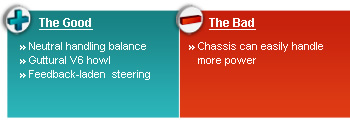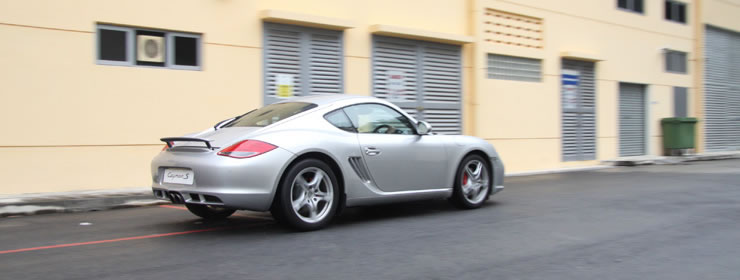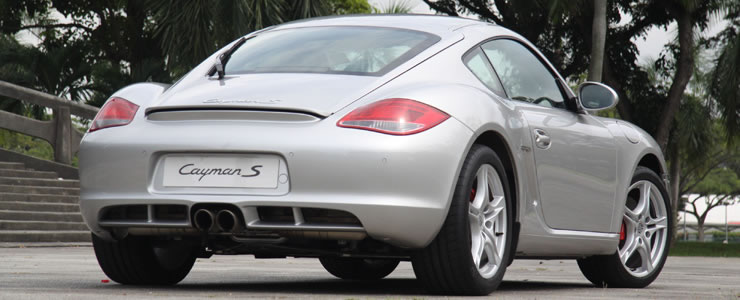Porsche Cayman S (A) Review
03 Sep 2010|15,117 views
The 911 is undeniably Porsche's more recognised model. After all, it has been around for coming to five decades (2013 will be its fiftieth anniversary year). Naturally, the Stuttgart-based sports car maker has long positioned 911 as the flagship model in its line-up.
Of course, there were always the entry-level models to cater to buyers for whom the 911 was just that bit beyond their reach. The 912 was the first of these entry-level models. It shared the same chassis and bodywork with the then 911, but behind the rear axle sat the four-cylinder motor from the 356.
Succeeding the 912 was the 914, a joint-development project with Volkswagen, in 1970. After that came the 924 in 1976, and its production continued until 1988. Unfortunately, there was no successor in sight to the 924 as Porsche had ran up considerable debts due to its inefficiency in both its production and management.
The next entry-level model to make its appearance was the Boxster roadster, which made its debut in 1996. It was joined by the Cayman in 2005.
This junior sports coupe from Porsche underwent a rather substantial mid-life refresh last year. We borrowed the Cayman S for a day and figured it to find out exactly what every enthusiast had been raving on about since its debut.
Of course, there were always the entry-level models to cater to buyers for whom the 911 was just that bit beyond their reach. The 912 was the first of these entry-level models. It shared the same chassis and bodywork with the then 911, but behind the rear axle sat the four-cylinder motor from the 356.
Succeeding the 912 was the 914, a joint-development project with Volkswagen, in 1970. After that came the 924 in 1976, and its production continued until 1988. Unfortunately, there was no successor in sight to the 924 as Porsche had ran up considerable debts due to its inefficiency in both its production and management.
The next entry-level model to make its appearance was the Boxster roadster, which made its debut in 1996. It was joined by the Cayman in 2005.
This junior sports coupe from Porsche underwent a rather substantial mid-life refresh last year. We borrowed the Cayman S for a day and figured it to find out exactly what every enthusiast had been raving on about since its debut.
 |
Outside it
The visual changes on the outside are just noticeable enough to differentiate this new car from its predecessor. Up front, you'll find not only a restyled front bumper - which now houses the obligatory daytime running lights - but also new headlamps. At the rear, the updates are the new LED tail lights and a new bumper.
Otherwise, its exterior styling has remained unchanged. The low, flat bonnet that sits between the raised front wings, the powerful rear haunches, the characteristics 'hockey stick' element along its flanks and the flowing C-pillar treatment that harks back to the 904 racing coupe - unmistakably Porsche.
 |
Inside it
Just like its exterior, the cabin is largely the same as the pre-facelifted car. Thanks to the new centre console, which it inherits from the 911, the whole ambience has improved, with the interior looking and feeling slightly classier than before.
As before, the driver is few with information via the three-dial instrument cluster and the cabin is fed with cold air from the air-conditioning system via the oval air outlets.
Since the test car only has the standard CDR30 audio system, it doesn't get the touch-screen full-colour display that only comes with the fitment of the PCM (Porsche Communication Management) infotainment system.
Driving it
Unlike other car maker's facelifts, Porsche's facelifts are rather extensive, and for the case of the Cayman S, it's given this coupe a fresh 3.4-litre flat six that features direct fuel injection, lifting its outputs to 320bhp and 340Nm (at 7,200rpm and 4,750rpm respectively).
Just like its exterior, the cabin is largely the same as the pre-facelifted car. Thanks to the new centre console, which it inherits from the 911, the whole ambience has improved, with the interior looking and feeling slightly classier than before.
As before, the driver is few with information via the three-dial instrument cluster and the cabin is fed with cold air from the air-conditioning system via the oval air outlets.
Since the test car only has the standard CDR30 audio system, it doesn't get the touch-screen full-colour display that only comes with the fitment of the PCM (Porsche Communication Management) infotainment system.
Driving it
Unlike other car maker's facelifts, Porsche's facelifts are rather extensive, and for the case of the Cayman S, it's given this coupe a fresh 3.4-litre flat six that features direct fuel injection, lifting its outputs to 320bhp and 340Nm (at 7,200rpm and 4,750rpm respectively).
It also gets the quick-shifting 7-speed PDK dual-clutch transmission from the 911, and with that, the Cayman S accelerates from a standstill to 100km/h in just 5.1 seconds, and onto a top speed of 275km/h. Use the launch control function (available only when the optional Sport Chrono package is specified on a PDK-equipped car) and you can shave 0.2 second off the 0-100km/h time - which, incidentally, is exactly the same as the entry-level 911 Carrera.
In the straights, the Cayman S is quick by any standard, but to truly appreciate it, you have to drive it on twisty, winding roads. The agility it possesses is simply awe-inspiring, the car seemingly pivoting about its mid-mounted motor, as the steering talks incessantly to the driver, providing him with the minute details of the on-goings at the front wheels.
The test car may be missing the optional PASM adjustable suspension, making do with the fixed-rate dampers, but the Cayman S still captivates with the way it keeps the body movements in check, at the same time, dealing with the bumps and ruts thrown at it by the asphalt.
In the straights, the Cayman S is quick by any standard, but to truly appreciate it, you have to drive it on twisty, winding roads. The agility it possesses is simply awe-inspiring, the car seemingly pivoting about its mid-mounted motor, as the steering talks incessantly to the driver, providing him with the minute details of the on-goings at the front wheels.
The test car may be missing the optional PASM adjustable suspension, making do with the fixed-rate dampers, but the Cayman S still captivates with the way it keeps the body movements in check, at the same time, dealing with the bumps and ruts thrown at it by the asphalt.
 |
If you find the car a tad too soft for your liking, you can firm things up by pressing the Sport button, which alters the characteristics of the engine, gearbox, throttle and steering for a sportier drive. There is also the Sport Plus button, but I'd recommend this mode to be used on really smooth surfaces, like on a racetrack.
The only gripe I have with the Cayman S are the steering wheel-mounted rocker switches used for manually changing gears. They are hardly intuitive, making it confusing for someone who just jumped into the car to use them correctly, but I guess a Cayman S owner will eventually get used to the operation with time.
The only gripe I have with the Cayman S are the steering wheel-mounted rocker switches used for manually changing gears. They are hardly intuitive, making it confusing for someone who just jumped into the car to use them correctly, but I guess a Cayman S owner will eventually get used to the operation with time.
Conclusion
I've had the good fortune to sample nearly all the models Porsche currently offers for sale, and I can say that, with the exception of the 911 GT models, the Cayman S is possibly the most involving Porsche to drive right now. Spec it with the 'right' options - which, to me, are the recently introduced paddle shifters, sports exhaust, rear limited slip differential, 19-inch alloy wheels and PCCB (Porsche Ceramic Composite Brakes) - and you have yourself a 911-slayer.
What do you think? Jot down your opinions at the comment box below.
I've had the good fortune to sample nearly all the models Porsche currently offers for sale, and I can say that, with the exception of the 911 GT models, the Cayman S is possibly the most involving Porsche to drive right now. Spec it with the 'right' options - which, to me, are the recently introduced paddle shifters, sports exhaust, rear limited slip differential, 19-inch alloy wheels and PCCB (Porsche Ceramic Composite Brakes) - and you have yourself a 911-slayer.
What do you think? Jot down your opinions at the comment box below.
The 911 is undeniably Porsche's more recognised model. After all, it has been around for coming to five decades (2013 will be its fiftieth anniversary year). Naturally, the Stuttgart-based sports car maker has long positioned 911 as the flagship model in its line-up.
Of course, there were always the entry-level models to cater to buyers for whom the 911 was just that bit beyond their reach. The 912 was the first of these entry-level models. It shared the same chassis and bodywork with the then 911, but behind the rear axle sat the four-cylinder motor from the 356.
Succeeding the 912 was the 914, a joint-development project with Volkswagen, in 1970. After that came the 924 in 1976, and its production continued until 1988. Unfortunately, there was no successor in sight to the 924 as Porsche had ran up considerable debts due to its inefficiency in both its production and management.
The next entry-level model to make its appearance was the Boxster roadster, which made its debut in 1996. It was joined by the Cayman in 2005.
This junior sports coupe from Porsche underwent a rather substantial mid-life refresh last year. We borrowed the Cayman S for a day and figured it to find out exactly what every enthusiast had been raving on about since its debut.
Of course, there were always the entry-level models to cater to buyers for whom the 911 was just that bit beyond their reach. The 912 was the first of these entry-level models. It shared the same chassis and bodywork with the then 911, but behind the rear axle sat the four-cylinder motor from the 356.
Succeeding the 912 was the 914, a joint-development project with Volkswagen, in 1970. After that came the 924 in 1976, and its production continued until 1988. Unfortunately, there was no successor in sight to the 924 as Porsche had ran up considerable debts due to its inefficiency in both its production and management.
The next entry-level model to make its appearance was the Boxster roadster, which made its debut in 1996. It was joined by the Cayman in 2005.
This junior sports coupe from Porsche underwent a rather substantial mid-life refresh last year. We borrowed the Cayman S for a day and figured it to find out exactly what every enthusiast had been raving on about since its debut.
 |
Outside it
The visual changes on the outside are just noticeable enough to differentiate this new car from its predecessor. Up front, you'll find not only a restyled front bumper - which now houses the obligatory daytime running lights - but also new headlamps. At the rear, the updates are the new LED tail lights and a new bumper.
Otherwise, its exterior styling has remained unchanged. The low, flat bonnet that sits between the raised front wings, the powerful rear haunches, the characteristics 'hockey stick' element along its flanks and the flowing C-pillar treatment that harks back to the 904 racing coupe - unmistakably Porsche.
 |
Inside it
Just like its exterior, the cabin is largely the same as the pre-facelifted car. Thanks to the new centre console, which it inherits from the 911, the whole ambience has improved, with the interior looking and feeling slightly classier than before.
As before, the driver is few with information via the three-dial instrument cluster and the cabin is fed with cold air from the air-conditioning system via the oval air outlets.
Since the test car only has the standard CDR30 audio system, it doesn't get the touch-screen full-colour display that only comes with the fitment of the PCM (Porsche Communication Management) infotainment system.
Driving it
Unlike other car maker's facelifts, Porsche's facelifts are rather extensive, and for the case of the Cayman S, it's given this coupe a fresh 3.4-litre flat six that features direct fuel injection, lifting its outputs to 320bhp and 340Nm (at 7,200rpm and 4,750rpm respectively).
Just like its exterior, the cabin is largely the same as the pre-facelifted car. Thanks to the new centre console, which it inherits from the 911, the whole ambience has improved, with the interior looking and feeling slightly classier than before.
As before, the driver is few with information via the three-dial instrument cluster and the cabin is fed with cold air from the air-conditioning system via the oval air outlets.
Since the test car only has the standard CDR30 audio system, it doesn't get the touch-screen full-colour display that only comes with the fitment of the PCM (Porsche Communication Management) infotainment system.
Driving it
Unlike other car maker's facelifts, Porsche's facelifts are rather extensive, and for the case of the Cayman S, it's given this coupe a fresh 3.4-litre flat six that features direct fuel injection, lifting its outputs to 320bhp and 340Nm (at 7,200rpm and 4,750rpm respectively).
It also gets the quick-shifting 7-speed PDK dual-clutch transmission from the 911, and with that, the Cayman S accelerates from a standstill to 100km/h in just 5.1 seconds, and onto a top speed of 275km/h. Use the launch control function (available only when the optional Sport Chrono package is specified on a PDK-equipped car) and you can shave 0.2 second off the 0-100km/h time - which, incidentally, is exactly the same as the entry-level 911 Carrera.
In the straights, the Cayman S is quick by any standard, but to truly appreciate it, you have to drive it on twisty, winding roads. The agility it possesses is simply awe-inspiring, the car seemingly pivoting about its mid-mounted motor, as the steering talks incessantly to the driver, providing him with the minute details of the on-goings at the front wheels.
The test car may be missing the optional PASM adjustable suspension, making do with the fixed-rate dampers, but the Cayman S still captivates with the way it keeps the body movements in check, at the same time, dealing with the bumps and ruts thrown at it by the asphalt.
In the straights, the Cayman S is quick by any standard, but to truly appreciate it, you have to drive it on twisty, winding roads. The agility it possesses is simply awe-inspiring, the car seemingly pivoting about its mid-mounted motor, as the steering talks incessantly to the driver, providing him with the minute details of the on-goings at the front wheels.
The test car may be missing the optional PASM adjustable suspension, making do with the fixed-rate dampers, but the Cayman S still captivates with the way it keeps the body movements in check, at the same time, dealing with the bumps and ruts thrown at it by the asphalt.
 |
If you find the car a tad too soft for your liking, you can firm things up by pressing the Sport button, which alters the characteristics of the engine, gearbox, throttle and steering for a sportier drive. There is also the Sport Plus button, but I'd recommend this mode to be used on really smooth surfaces, like on a racetrack.
The only gripe I have with the Cayman S are the steering wheel-mounted rocker switches used for manually changing gears. They are hardly intuitive, making it confusing for someone who just jumped into the car to use them correctly, but I guess a Cayman S owner will eventually get used to the operation with time.
The only gripe I have with the Cayman S are the steering wheel-mounted rocker switches used for manually changing gears. They are hardly intuitive, making it confusing for someone who just jumped into the car to use them correctly, but I guess a Cayman S owner will eventually get used to the operation with time.
Conclusion
I've had the good fortune to sample nearly all the models Porsche currently offers for sale, and I can say that, with the exception of the 911 GT models, the Cayman S is possibly the most involving Porsche to drive right now. Spec it with the 'right' options - which, to me, are the recently introduced paddle shifters, sports exhaust, rear limited slip differential, 19-inch alloy wheels and PCCB (Porsche Ceramic Composite Brakes) - and you have yourself a 911-slayer.
What do you think? Jot down your opinions at the comment box below.
I've had the good fortune to sample nearly all the models Porsche currently offers for sale, and I can say that, with the exception of the 911 GT models, the Cayman S is possibly the most involving Porsche to drive right now. Spec it with the 'right' options - which, to me, are the recently introduced paddle shifters, sports exhaust, rear limited slip differential, 19-inch alloy wheels and PCCB (Porsche Ceramic Composite Brakes) - and you have yourself a 911-slayer.
What do you think? Jot down your opinions at the comment box below.
Car Information
Porsche Cayman S 3.4 PDK (A)
CAT B|Petrol|10.2km/L
Horsepower
239kW (320 bhp)
Torque
370 Nm
Acceleration
5.2sec (0-100km /hr)
This model is no longer being sold by local distributor
All Used Porsche CaymanThank You For Your Subscription.













































